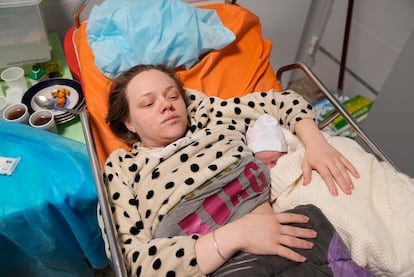Pregnant woman who survived Russian strike on maternity hospital dies days later
The victim’s child was born ‘without signs of life,’ while another survivor of the bombing has given birth to a girl
It was an image that spread across the world and came to symbolize the darkest face of Russia’s war against Ukraine: a heavily pregnant woman, covered in blood and holding her stomach, as she is taken away on a stretcher. The expression on her face is one of shellshock. The photograph was taken on March 9 after Russia bombed a maternity hospital in the southeastern Ukrainian city of Mariupol. The woman had survived the attack and was being transported to the emergency ward of another hospital. On Monday, the Associated Press (AP) news agency learned that the woman and her baby had died.
Despite the efforts of the emergency services, nothing could be done to save the woman and her child. Once transferred to the second hospital, near the front line between Russia and Ukraine, a team of doctors tried to keep her alive, according to AP. Surgeon Timur Marin told the news agency that the woman had a crushed pelvis and detached hip. The doctors performed an emergency cesarean section, but the child showed “no signs of life,” the surgeon said. According to Marin, when the woman realized she was going to lose her baby, she screamed: “Kill me now!”
The surgeon said that they had tried to resuscitate the woman for more than 30 minutes, but were unable to revive her. The medics were not able to identify the woman amid the chaos of Wednesday’s attack, which killed three people, including a young girl, and injured 17 others. The woman’s father and husband retrieved her body from the hospital, unlike many other victims of the war in Mariupol, who have been buried in mass graves due to the overwhelming numbers of casualties.
Baby born amidst the ruins
The other face of the conflict in Ukraine is Mariana Vishegirskaya, a 19-year-old who was able to flee the maternity ward in Mariupol when the Russian airstrike hit. Like the unnamed victim, she was covered in blood and in a state of shock when she escaped the hospital. On Friday, two days after the attack, Vishegirskaya was transferred to another hospital, where she gave birth to Veronika, a survivor just like her mother.

When a photo of Vishegirskaya, climbing down the stairs amid the ruins with a plastic bag in her hand, was shared on social media, the Russian Embassy in the United Kingdom claimed on Twitter that it was a fake and that the woman was a social media influencer called Mariana Podgurskaya. The embassy argued that she had painted blood on her face to make it look like she was a victim, and that the photo had been staged. Twitter eliminated the posts sharing the conspiracy theory. Following the bombing of the maternity hospital in Mariupol, Russia’s foreign affairs minister, Sergey Lavrov claimed that it was the site of an alleged neo-Nazi Ukrainian battalion.
Tu suscripción se está usando en otro dispositivo
¿Quieres añadir otro usuario a tu suscripción?
Si continúas leyendo en este dispositivo, no se podrá leer en el otro.
FlechaTu suscripción se está usando en otro dispositivo y solo puedes acceder a EL PAÍS desde un dispositivo a la vez.
Si quieres compartir tu cuenta, cambia tu suscripción a la modalidad Premium, así podrás añadir otro usuario. Cada uno accederá con su propia cuenta de email, lo que os permitirá personalizar vuestra experiencia en EL PAÍS.
¿Tienes una suscripción de empresa? Accede aquí para contratar más cuentas.
En el caso de no saber quién está usando tu cuenta, te recomendamos cambiar tu contraseña aquí.
Si decides continuar compartiendo tu cuenta, este mensaje se mostrará en tu dispositivo y en el de la otra persona que está usando tu cuenta de forma indefinida, afectando a tu experiencia de lectura. Puedes consultar aquí los términos y condiciones de la suscripción digital.
More information
Últimas noticias
David Bowie, the galactic thinker who encouraged us to break new ground
John Berger and the loss of rural culture
From police officer to bloodthirsty kidnapper: Terror in Mexico during the years of ‘The Ear Chopper’
Alain Aspect, Nobel laureate in physics: ‘Einstein was so smart that he would have had to recognize quantum entanglement’
Most viewed
- David King, chemist: ‘There are scientists studying how to cool the planet; nobody should stop these experiments from happening’
- Reinhard Genzel, Nobel laureate in physics: ‘One-minute videos will never give you the truth’
- Oona Chaplin: ‘I told James Cameron that I was living in a treehouse and starting a permaculture project with a friend’
- Sinaloa Cartel war is taking its toll on Los Chapitos
- Mexico completes its trade shift with the entry into force of tariffs on China and countries without trade agreements











































